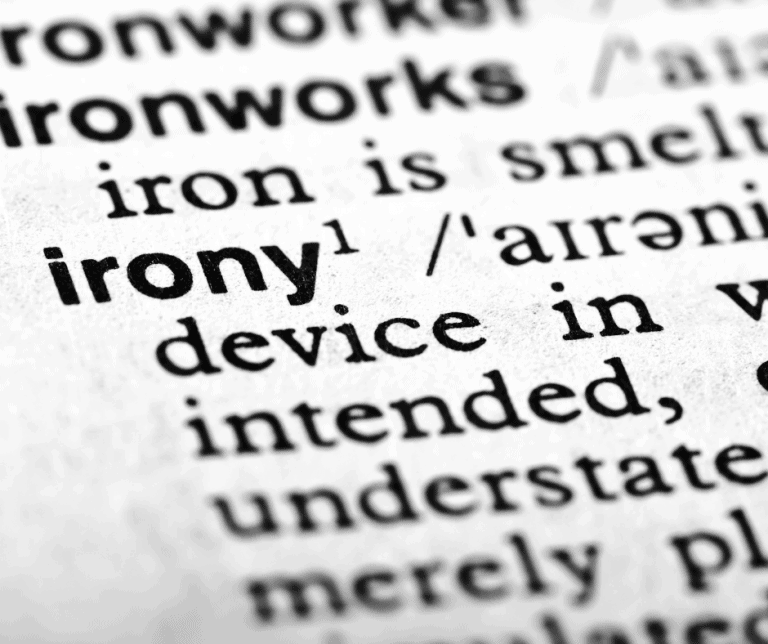Irony is an excellent literary device you can use in your work for one simple reason—we’ve all experienced it so we all know what it’s like and the frustrations, comedy and even tragedy it can entail.
Use it skillfully, and you’ll add extraordinary depth to your writing. Let’s take a deep dive and get you well versed in what it is, how it works, the different types of irony available, and how to use it.
What is irony?
Irony is when something said or expected is different from what actually happens.
In other words, it’s the opposite of expectation. What we think will happen doesn’t, and that, in turn, creates conflict, frustration, complexity, suspense, difficulty, and so on.
As you all will know by now, these are crucial elements to any good plot, and they create excellent building blocks by which you can hook your reader in and keep them engaged to continue reading.
Think of it as an excellent literary device you can use in your stories. The great thing is that there are limitless ways you can use it, given the variety of forms it occurs in.
Types of irony: definition and examples
There are several different types of irony that are sad, funny, tragic, and satirical.
Dramatic irony
This kind of irony occurs when we, as the reader, know more than the characters in the plot. This might seem like a spoiler, say, for example, if you tell the reader there’s a danger in the scene that the characters don’t know about, yet they are racing towards it or continuing unawares. But you can actually use it for maximum effect by showing the reader what happens when a character is finally confronted by the danger. These kinds of scenes lead to heightened tension because the reader cannot intervene and warn the characters.
William Shakespeare’s Romeo and Juliet is one of the best examples of dramatic irony. In the final scenes, the reader understands Juliet has only taken a sleeping potion to fake her death. But Romeo doesn’t know this. When he wakes, he thinks she is really dead and kills himself. “Here’s to, my love!” he says as he drinks. “O true apothecary! Thy drugs are quick. Thus with a kiss I die.” The ultimate dramatic irony and tragedy.
Situational irony
Situational irony occurs when we expect one thing and get the opposite. So there’s a distinct contrast between the audience’s expectations and the actual outcome of the situation. In this way, the audience gets something unexpected, a twist if you like. It keeps them guessing, builds tension and suspense.
For example, a fire station might burn down or a police station robbed, a man that needs help is run over by an ambulance, a marriage counselor files for divorce, a murderer is murdered, a pilot has a fear of heights, etc.
Situational irony can be used to great effect in sitcoms, comedies, dramas and tragedies in any format from television to film or on the written page.
James Cameron’s sequel to the Terminator is considered to be one of the finest examples of situational irony in film. We all remember the scene in which Sarah Connor is doing her chin-ups, right? Well, soon after this, she attempts to escape from the mental institution she’s being held in for her delusions about a Terminator killing her and the end of the world. During her escape, she is confronted by the same Terminator, only this time he’s come to protect her. Situational irony.
And it works. Terminator 2: Judgment Day was a huge box office hit. It gave the audiences something they didn’t expect, using the same characters from the first film.
Verbal irony
This kind of irony happens when a character says something and means the opposite. This results in a clash between their literal and intended meaning. Sarcasm is probably the verbal irony we’re most familiar with, but it is just one of the subtypes. There is also understatement, overstatement or Socratic irony (feigning ignorance), and is often used for humour but not always.
So, a character might say “fantastic” when the situation is bad, “we don’t get along” after a huge fight.
Shakespeare was excellent at using verbal irony. In Hamlet, when the protagonist is asked where Polonius is, he replies, “But if indeed you find him not in this month, you shall nose him as you go up the stairs into the lobby.” In other words, Polonius is dead.
J. K. Rowling also used verbal irony to great effect in Harry Potter and the Order of the Phoenix when Harry says, “Yeah, Quirrell was a great teacher. There was just that minor drawback of him having Lord Voldemort sticking out of the back of his head!”
Conclusion
Irony is a great way to make things shift, seem, or result in something quite different to the initial expectation. This contrast makes it a rich and effective device in storytelling as you keep readers on their toes, guessing, surprised, and on the edge of their seats.
It will not only add a layer of depth to your story, but you will surprise and confound your reader. And that’s always a great achievement as a writer! It is an excellent literary device because it often strikes at our emotions and reminds us of situations we’ve faced. Why not try it yourself?



















